- Best Firewood Carriers Guide: Which is Right for You? - July 27, 2022
- Water Oak Tree Guide: All You Need to Know - July 16, 2022
- How to Find the Best Chainsaw Helmet to Protect Yourself - July 10, 2022
It seems that all cutting tools today—whether it’s a circular saw, jigsaw, compound miter saw, or reciprocating saw—are powered by some sort of motor. This makes handsaws seem like antiquated tools; something that was used eons ago.
While it may seem that cutting requires a power saw of some sort, the truth is that a handsaw still remains an essential tool in many workshops. Sometimes you can’t get the job done without the best handsaw.
If you’re looking for the best handsaws for your workshop, continue reading to learn what you should consider when shopping for a handsaw and why we think our top handsaw picks make good recommendations.
Parts of a Handsaw
A handsaw consists of two fundamental parts: the handle and the blade.
- The bottom of the blade is where the teeth of a handsaw are and is known as the front, while the top of the blade is known as the back.
- The blade’s heel is the cutting edge that’s nearest the handle, while the opposite end of the heel is known as the toe.
- Tapered blades are featured in many saws, getting progressively leaner from the teeth all the way up to the top of the blade (also called the back). This tapering helps the blade avoid getting stuck when cutting deep into the wood.
- Certain saws like dovetail, Dozuki, and tenon saws feature reinforcing spines along the length of the top of the blade. This feature provides the thin blade with added support, preventing the blade from bending or buckling when cutting.
- The teeth of most saws are set, which means they’re slightly bent sideways to the blade’s main body. The teeth are arranged alternately; one tooth is set to the left while the next tooth is set to the right and so on. This pattern is repeated along the entire length of the cutting edge.
- This alignment widens the cutting edge and prevents the handsaw from getting stuck while you’re cutting deep.
Advantages of Using a Handsaw
Precision cuts: Although handsaws need more elbow grease than power saws, they definitely give you more control when cutting. This allows you to make better precision cuts on pliable materials. The scroll saw is another type of saw to consider particularly if you’re cutting very thin materials.
No source of power needed: Since handsaws don’t require any external power source, they’re a convenient cutting tool. This means the device can be used in any environment without the need for cables or batteries.
Safety: The manual working of a handsaw makes the tool much slower, so you’re far less likely to lose grip of the device. Therefore, handsaws are much safer to use than power tools.
Types of Handsaws
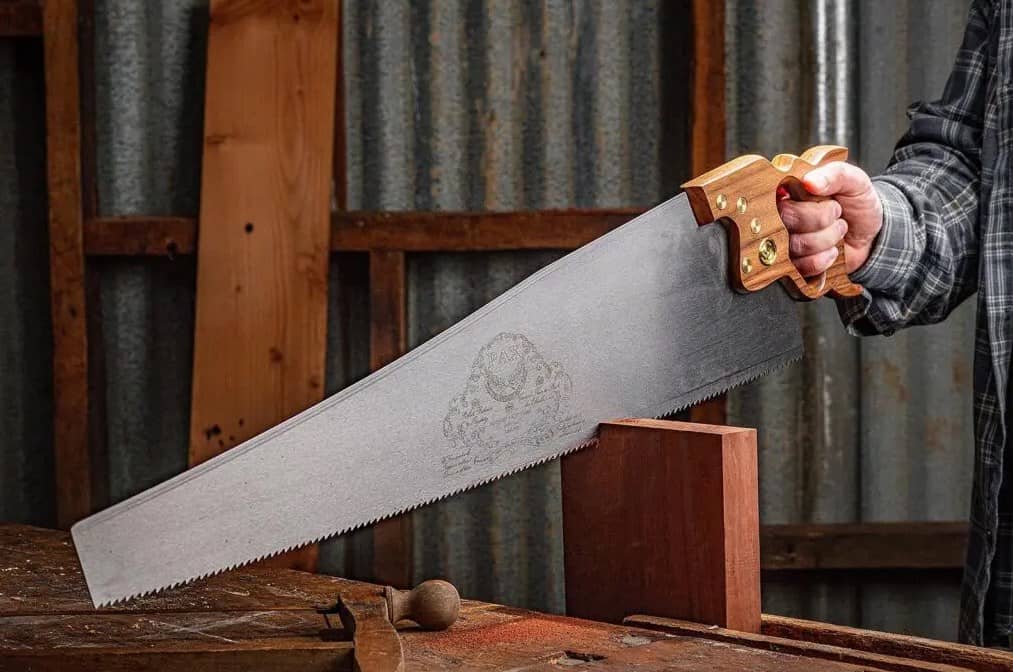
There are various styles of handsaws, each made for a variety of purposes:
General-purpose handsaw: This handsaw is perfect for the standard sawing of wood. It has a huge blade for making fast, straight cuts. Due to its huge blade, however, this kind of handsaw isn’t suitable for making smaller, more precise, and intricate cuts.
The standard general-purpose handsaw is used both around the home and in professional settings. It’s very versatile and certainly up to the job.
Bow saw: This saw is built for fast and forceful cutting, which means it leaves a rougher finish. It’s usually used for cutting logs and tree branches.
Coping saw: This is the most versatile handsaw on the market and is perfect for cutting through soft and hardwood, non-ferrous metals, ceramic, and plastic. Its thin narrow blade may be replaced as frequently as possible if necessary, which will save you cash in the long term.
Due to its thinner, smaller design, this saw is ideal for making complex curved cuts that’d otherwise not be possible with other types of handsaws. Since it has a very small blade, this saw can easily cut skirting.
Pruning saw: A pruning saw is most commonly used in the garden for making deep cuts in shrubs and tree branches.
Tenon saw: This saw makes precise and straight small cuts in soft and hardwood. Due to its high number of teeth per inch, it leaves the wood with a neat finish. The blade on a tenon saw also doesn’t flex, giving you total control of cuts.
Pull saw: Pull saws come in many variations and they’re particularly popular among Japanese woodworkers. The Dozuki and Ryoba handsaws are two good examples of pull saws. The shape of the blade can change to improve certain functions, but the standard principle is still the same.
Pull saws are named so because pulling the stroke rather than the pushing stroke makes the cut. They’re very popular because they offer greater control for making accurate cuts more quickly.
Backsaw: This saw is almost the same as a back-cut handsaw because it’s designed for use only on wood, but there are certainly major differences. The most obvious difference is that a backsaw features a thin blade. There’s an armored back edge along the blade, hence the name “backsaw”.
The fine-tooth and thin blade design make backsaws perfect for woodworking as well as other high-detail tasks. They’re particularly useful for cutting miters and dovetails.
Crosscut saw: This handsaw is the most iconic variant and is what we all think of when we hear the name. This is a wonderful all-purpose model that cuts wood vertically. Size and tooth style may vary a little with this kind of handsaw.
Fine teeth are ideal for making intricate cuts in woodworking tasks, while wide teeth are perfect for log bucking or making rough cuts. In addition, large saws feature coarse teeth to boost speed while smaller saws often feature fine teeth that are easier to deal with.
Handsaw Blade
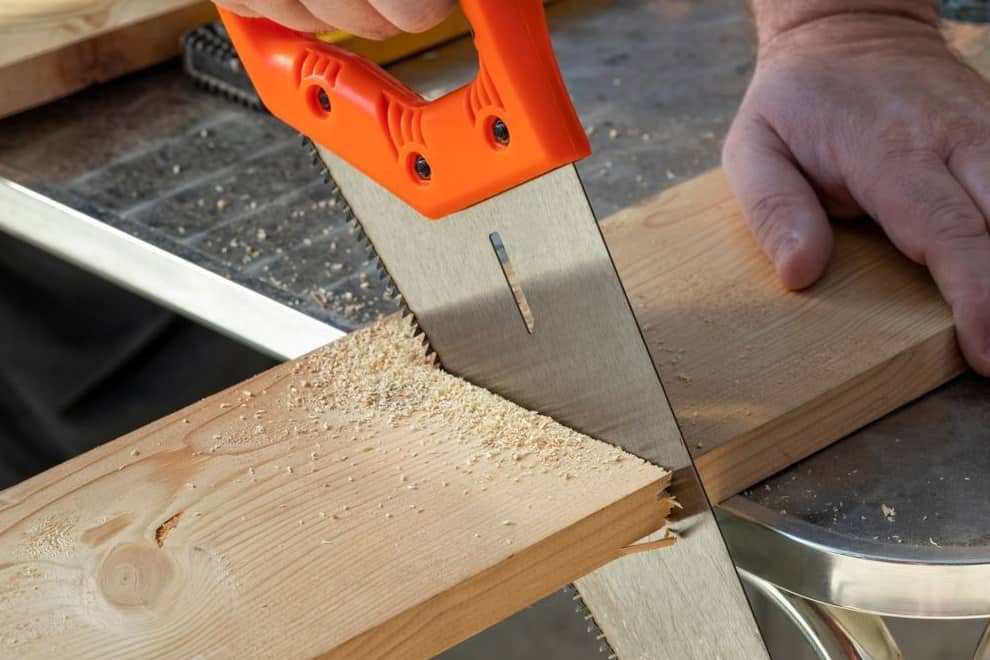
Handsaw blades are made from a hardened steel combination that prevents the premature dulling of the teeth. While the blades use one material, their shapes may vary considerably depending on the kind of saw as well as its purpose.
- A regular general-purpose panel saw has a long, wide blade with huge teeth that make fast, coarse cuts through wood.
- Woodworking saws have thin blades that allow for precise cuts. The blade will cut in an arc and won’t get stuck mid-stroke. Some woodworking saws are also cut via pulling strokes, which improves accuracy.
- Hacksaws feature thin blades with numerous teeth and zero spaces, allowing them to easily cut through plastic or metal.
- A jab saw features a narrow, long blade with huge teeth designed to quickly cut through drywall material.
Handsaw Teeth
The teeth of a handsaw determine how fast it slices through wood as well as how precise its cuts are. The number of teeth is commonly known as teeth per inch, or TPI for short. The fewer the teeth per inch, the bigger will be the teeth and the bigger will be the gaps (gullets) between.
Blades with at least 10 teeth per inch feature smaller teeth with hardly any spaces between them. The more the teeth in each inch, the smoother will be the cut. But because you’re sinking more teeth into the wood, you’ll require much more effort to cut through it.
Coarse-tooth blades feature 1-7 teeth per inch. With these blades, you can quickly cut through huge pieces of material, though not smoothly. The huge teeth rip some of the fibers of wood, producing a rough finish.
How you intend to use your handsaw will determine your ideal TPI. For instance, rip-style blades have about five teeth per inch and are thus built to quickly cut along the wood’s grain. On the flip side, crosscut blades have 10-12 teeth per inch and are therefore built to make more precise cuts.
Teeth also affect how a handsaw cuts. Blades with sharp teeth on both sides will cut via both the pull and push strokes. However, blades with sharp teeth on only one side will cut either through the pull or push stroke, not both.
Handsaw Flex
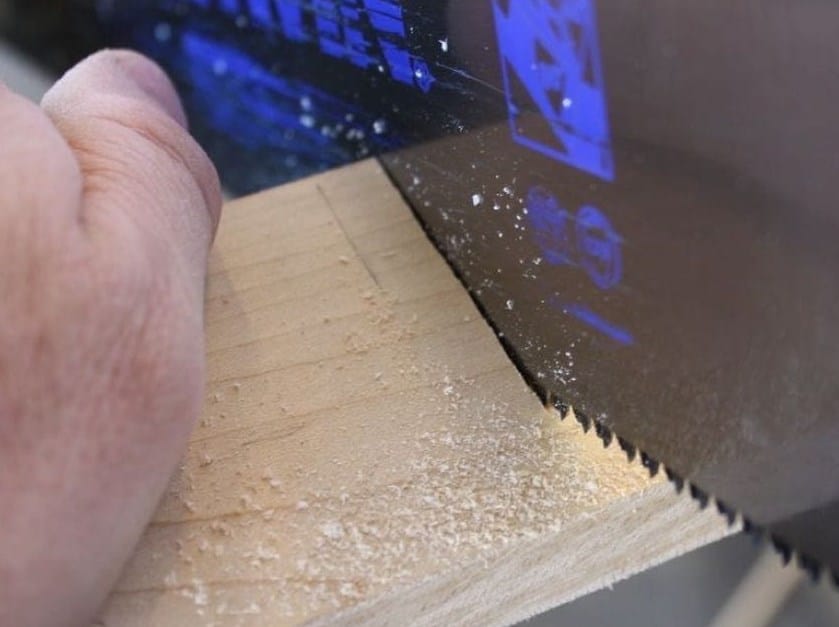
Most handsaws have innate flex, which means the blade will change direction.
A handsaw’s flex can make it difficult to make straight cuts. Handsaws with thicker blades are more rigid but need more effort to rip through the material. On the other hand, thinner blades will cut through the material faster but have extra flex.
Some handsaws are built to beat this flex issue through styles that reinforce the blade. For instance, hacksaws have a frame that supports the blade on either side. The frame features an adjusting screw to create tension and prevent the blade from flexing when cutting harder materials like metal and plastic.
Woodworking handsaws cut only via pulling strokes. Pulling creates tension that makes the blade straighten naturally during the cutting motion.
Handsaw Handle
Given that a handsaw is operated manually, the handle is an equally important component. A handsaw with a poorly built handle will be uncomfortable to use and difficult to control. Many saws are made with ergonomically designed handles with rubber grips to maximize comfort and control.
But that’s not the case with every handsaw. Some manufacturers produce saws with traditional, good-looking, stained wood handles. This design can sacrifice comfort, but a handsaw with this classic look will definitely give your workshop some character.
Handsaw Length
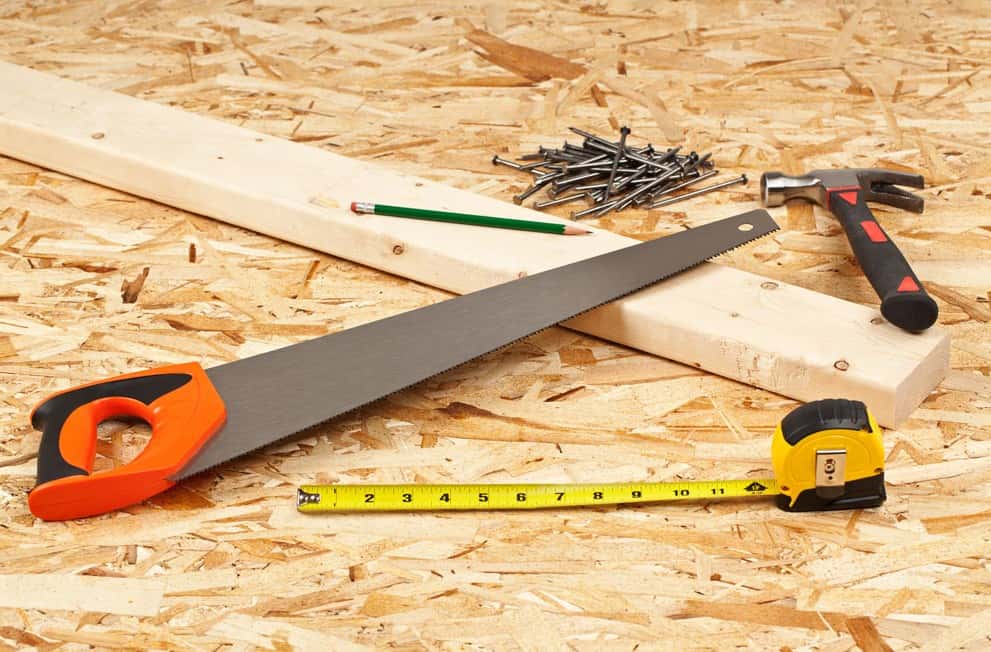
The length of a handsaw is its cutting edge alone. Longer saws will rip through more material, which means a cut will need fewer strokes. Also, longer saws tend to produce a more consistent and even cutting line.
Having said that, your ideal saw length will be determined by your personal preference. A smaller person with a shorter stretch might find a 15-inch handsaw useful, while someone with a longer stretch might feel more at home with a 26-inch handsaw.
Handsaw Tension
Good blade tension is essential for making a straight, even cut. When the saw blade is pressed against something solid, it should bend a little.
A well-designed saw blade will create an even curve when bent, which means it shouldn’t curve at a more acute angle in any spot. When the blade is released, it should instantly go back to straight.
Certain handsaws are built to generate blade tension. For instance, the c-shaped frame of hacksaws connects to opposite ends of the saw blade. The tension adjustment feature lets you increase the blade’s tension, making it stiffer.
Some saws will create the rigidity that’s required to cut through tougher materials like metal.
Our Top Picks
Best Overall Handsaw: WilFiks 16” Pro Handsaw
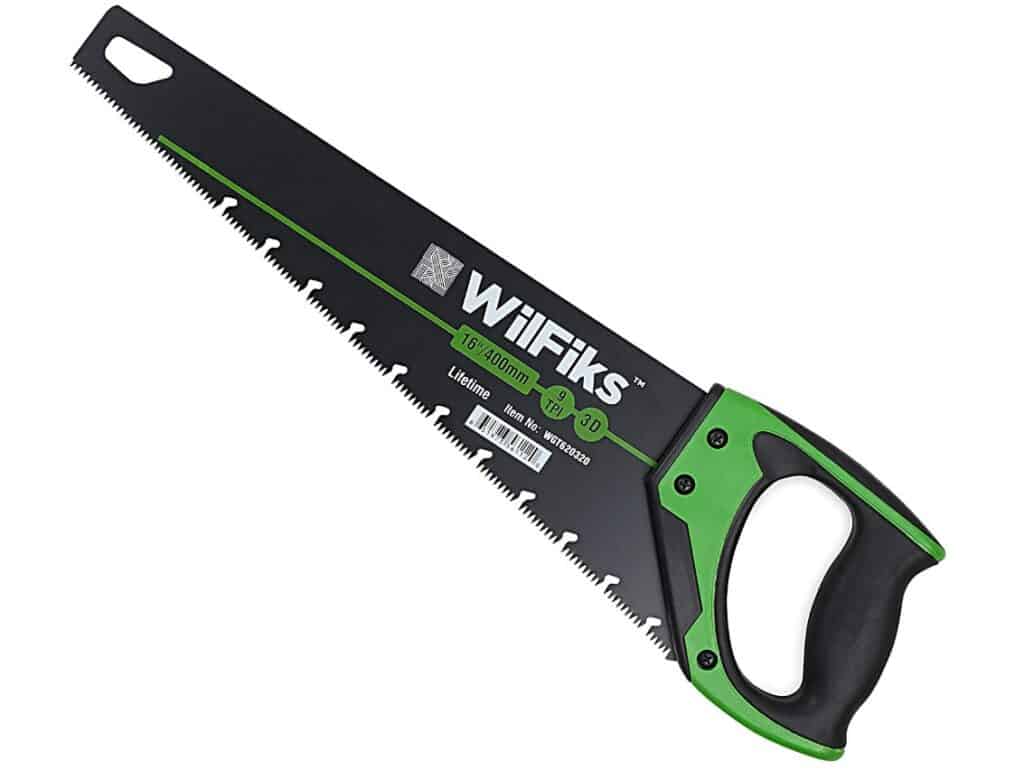
Most DIY enthusiasts want a handsaw that can carry out many different tasks. With its nine teeth per inch and deep gaps, the WilFiks 16” Pro Handsaw can make quick crosscuts through your wood, rip boards, as well as make the odd cut through a log. It’s got sufficient flex to be safer but can still achieve rapid cutting.
With its 16-inch blade, this saw lets you make long strokes that slice in either direction, which accelerates the cutting process. With to its lightweight build, the saw is comfortable to use as well.
It weighs under 1 pound and features a slip-resistant ergonomic grip that offers both comfort and control. Thanks to its comfortable handle and versatile design, this is an awesome handsaw for everyday tasks.
Best Value Handsaw: CRAFTSMAN 15” Handsaw (CMHT20880)
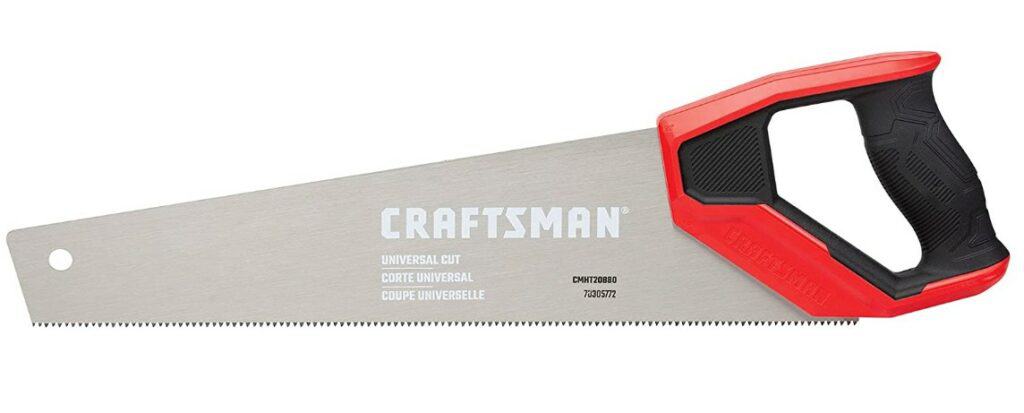
Handsaws are far much cheaper than power saws, as the price of the CRAFTSMAN 15-inch Handsaw (CMHT20880) shows. This saw has a tooth set that cuts deeper on the downstroke and makes minor cuts on the backstroke for quick, smooth cuts. Thanks to its induction toughened teeth, this handsaw won’t dull any time soon.
For extra control, this saw features a thickset handle, providing you with something substantial to grip, in addition to an ergonomic rubberized grip, for better control when cutting through thicker boards.
In addition, the handle features built-in 45-degree and 90-degree angles, allowing you to draw accurate cut lines with the blade’s dull side.
Best for Furniture-Making: SUIZAN 9.5” Japanese Ryoba Steel Pull Saw
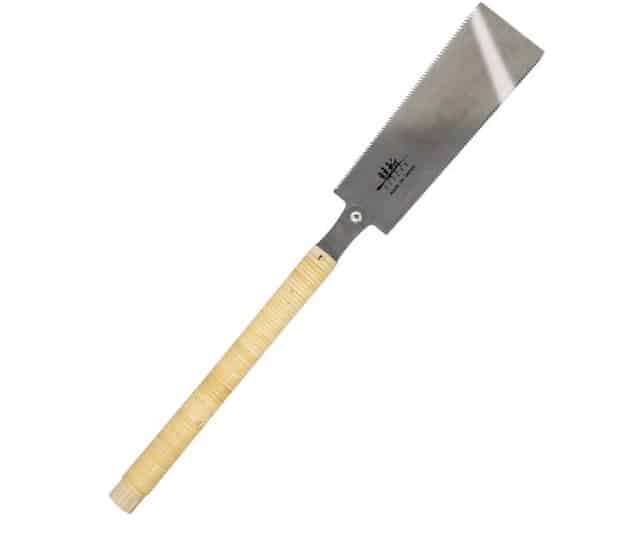
The majority of Western-style handsaws are cut via pushing strokes rather than pulling strokes. The SUIZAN 9.5” Japanese Ryoba Steel Pull Saw flips the script and cuts via pulling strokes.
What’s the benefit? Pull saws enable more precise cuts. This handsaw also has a thin blade, enabling it to effortlessly cut through wood.
There are two blades in this pull saw: a coarse-tooth side with bigger, more aggressive teeth that make rip cuts, and a fine-tooth side for making smooth crosscuts. These features make the SUIZAN Japanese Ryoba Steel Pull Saw a perfect fit for fine carpentry.
Made of Japanese Ryoba steel, its blades are durable and extremely sharp. A rubberized handle offers lots of grip for exceptional control.
Best for Cutting Metal: LENOX Tools 12” High-Tension HackSaw (12132HT50)
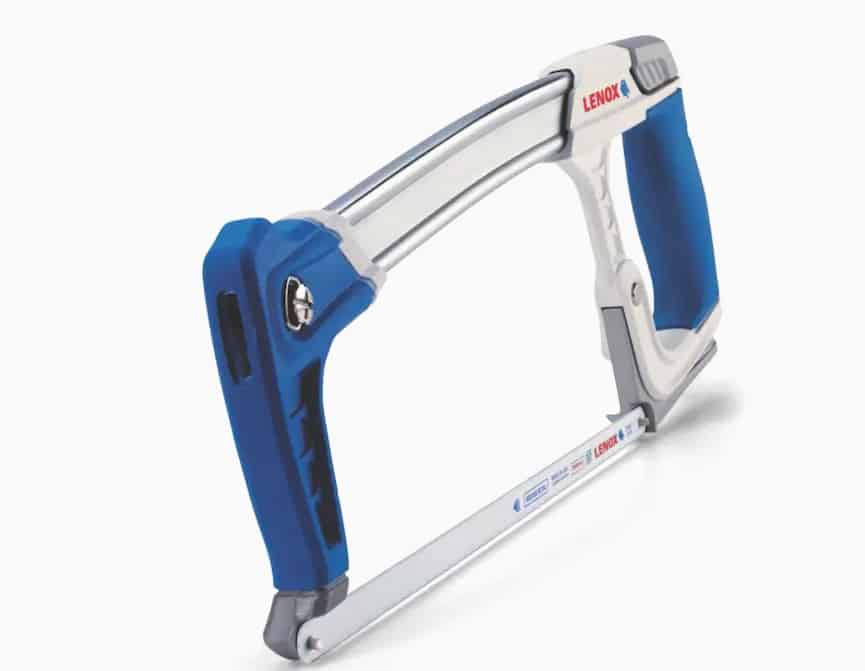
If you want to cut metal effectively, only a high-tension blade will guarantee a straight cut. So how much tension do you require?
The LENOX Tools 12-inch High-Tension Hacksaw creates up to 50,000 pounds-per-square-inch of tension, ensuring that you can make straight cuts through even the hardest materials.
The ergonomic rubberized grip gives you excellent control of the handsaw as you cut metal. This handsaw also offers loads of hidden features, such as a handy storage space for as many as five blades as well as a bracket for another blade than turns the device into a jab handsaw.
Best for Cutting Plastic: AIRAJ 12” Adjustable-Tension Hacksaw Frame
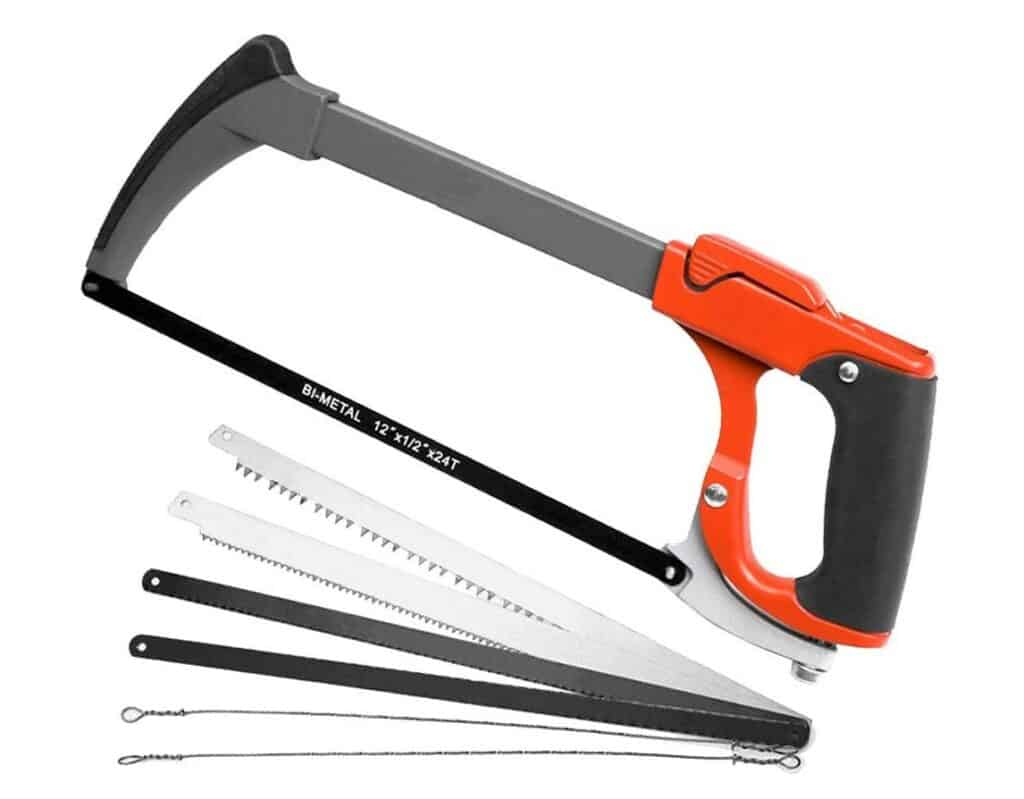
The AIRAJ 12-inch Hacksaw Frame with Adjustable Tension is surprisingly versatile. Thanks to its ergonomic handle and high-grade steel blades, it easily cuts through plastic, metal, and wood materials. It also boasts a convenient adjuster for modifying the blade’s tension spontaneously, letting you maximize its cutting performance.
This saw features two bracket sets that let you cut at the conventional 45 degrees or 90 degrees. Its rubberized grip provides comfort and control.
Another grip at the other end allows you to use two hands when making difficult cuts. The saw is well-designed with 10 high-grade steel blades.
FAQs on How to Find the Best Handsaws
Question: What Are the Top-of-the-Range Handsaws on the Market?
Answer: The best handsaws for your workshop today include:
• WilFiks 16” Pro Handsaw
• CRAFTSMAN 15” CMHT20880 Handsaw
• LENOX Tools 12” 12132HT50 High-Tension Hacksaw
• DEWALT DWHT20540 Jab Saw
• AIRAJ 12” Hacksaw Frame with Adjustable Tension
• SUIZAN 9.5” Japanese Ryoba Steel Pull Saw
Question: How Do I Select a Good Handsaw?
Answer: As a rule of the thumb, the fewer the teeth in a handsaw, the more coarse, rougher, and faster is the cut. Therefore, a rougher handsaw with larger but fewer teeth is better suited to making rip cuts along the grain.
A saw with smaller/finer teeth is ideal for making smoother cuts in more intricate kinds of wood for a finer, neater finish.
Question: What should I Consider When Buying a Woodworking Saw?
Answer: One of the key factors that determine how a handsaw is cut is its tooth count. More teeth mean the saw will provide a more precise, cleaner cut. Fewer teeth cut fast but don’t make an accurate, neat cut.
Question: What’s the Best Handsaw for Wood?
Answer: The best saw for cutting across a grain of the wood is a crosscut saw. The teeth of this saw angle backward while cutting with pulling and pushing strokes for an accurate and clean cut. A crosscut saw cuts logs vertically, or it can work alongside a saw hook.
Question: What’s the Sharpest Handsaw?
Answer: The sharpest handsaws for woodworking include:
• STANLEY FATMAX 15” 20-045 Handsaw
• Ryoba 9.5″ Double-Edge Hardwood Razor Saw
• GreatNeck 26” N2610 Crosscut Saw
• Shark Corp 12” 10-2312 Carpentry Saw
• Vaughan Pull Stroke BS240P Handsaw
• IRWIN Tools 15” 1773465 Universal Handsaw
• Crown FLINN1 10” Dovetail Saw
Last Word on How to Find the Best Handsaws
A handsaw is an essential tool in any garage or workshop. Unlike other kinds of saws, it requires no source of power to work. You only need a little bit of effort to make use of it.
Since there are plenty of different options out there when shopping for a handsaw, make sure to carefully consider the factors we’ve covered above and check out our best handsaw options on the market.
Not all handsaws are made the same. How often you use the handsaw is also a crucial factor to consider. If you’re going to use it frequently, you might want to go for a pricier but affordable model.
It’s our hope that you’ve found this handsaw buying guide valuable so you can find the best handsaw for your own unique needs.
